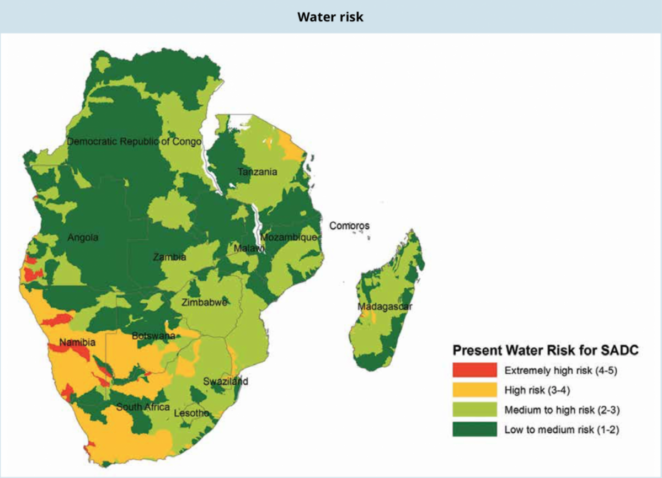Climate Risk and Vulnerability: A Handbook for Southern Africa (2nd Edition)

Introduction
It is clear that global warming and climate change may no longer be ignored. The climate of southern Africa has undergone significant warming. The impact of this warming world now touches every facet of regional social and economic progress. The vulnerability of southern African societies and ecosystems is critical. Future sustainable development is contingent on the capacity to adapt to the impacts of climate change.
The second edition of the Handbook for Southern Africa on Climate Risk and Vulnerabilityfollows on the entry into force of the Paris Climate Change Agreement of 2016. The handbook launches a series of re-definitions, concepts and programmes for addressing climate change and serves as an important guide for climate and development practitioners, students and policy-makers.
The handbook is presented in three parts and guides the reader through a simplified understanding of climate risks, vulnerability to climate change and actions to cope with the impact of climate change by connecting adaptation, mitigation and sustainable development, regional climate change strategies, climate change adaptation and disaster risk reduction, climate financing, sustainability and corporate governance. It includes an analysis of observed and projected climate change over southern Africa, and the socio-economic impacts of extreme weather events in southern Africa. Key sectors are selected to illustrate best practices in assessing vulnerability – agriculture and livestock, commercial forestry, terrestrial ecosystems and biodiversity, water resources, the coastal zone, settlements, human health, energy and air quality.
This comprehensive handbook serves as an important guide for climate and development practitioners, students and policy-makers.
*Download the full handbook from the right hand column. Executive summary is available in English and Portuguese – see Further Resources below. The key messages from the report are provided below. See the full text for much more detail.
Lessons Learnt
The handbook presents a series of key messages about climate change, and its impacts, for Southern African societies which are both contemporaneous and predicted for the future. These are summarised by the short animation above and as follows:
Climatic changes
- Southern Africa has been warming significantly over the last century. For the period 1961 to 2014 temperatures over the region have increased at a rate of 0.4 °C per decade.
- Warmer conditions are likely over most of the interior of southern Africa in the future, with more frequent very hot days (> 35 °C).
- High year-to-year rainfall variability is typical in the region, and there is little evidence for a substantial drying or wetting to date.
- In the future, a decrease in rainfall is projected over central southern African (e.g. northern Botswana, Namibia, southern Zambia and Zimbabwe) and over the southwestern Cape of South Africa. An increase in rainfall is projected over northern Mozambique and Tanzania.
Impacts
- Over the past four decades (1980-2016) weather-related disasters in SADC have resulted in damages in the region of 10 billion USD, have left 2.47 million people homeless and affected a further 140 million people.
- Vulnerability to climate change is not only caused by the level of exposure, but also by social, economic and other environmental factors that interact with the changing climate.

Sectoral impacts
- The risks posed by climate change will likely result in a range of negative impacts across the region, many of which are cross-cutting through key sectors.
- With appropriate responses, climate change need not always be detrimental, and proactive responses can exploit opportunities for climate-resilient development.

Recommendations
In light of the challenges posed to Southern Africa by changing climates, the handbook recommends responses based on four broad categories as follows:
- Integrating climate change adaptation and disaster risk reduction through a risk management approach will help to reduce future losses from climate extremes.
- The transboundary nature of climate change necessitates regional cooperation and action.
- Enabling synergies among mitigation and adaptation actions is required to support sustainable development and the creation of more efficient, responsive and comprehensive climate policies.
- Utilising the increasing resources available to respond to climate change being made available through various mechanisms, such as the Green Climate Fund.
The project is funded by USAID with the support of the Department of Science and Technology (DST), South Africa. The authors would like to acknowledge the Applied Centre for Climate and Earth Systems Science (ACCESS), the Southern African Science Service Centre for Climate Change and Adaptive Land Use (SASSCAL), and the Future Climate for Africa UMFULA (Uncertainty Reduction in Models for Understanding Development Applications consortium) project for supporting the research presented in the handbook.
This work was [partially] carried out under the Future Climate for Africa UMFULA project with financial support from the UK Natural Environment Research Council (NERC), and the UK Government’s Department for International Development (DFID).
Suggested citation
Davis-Reddy, C.L. and Vincent, K., 2017. Climate Risk and Vulnerability: A Handbook for Southern Africa (2nd Ed). CSIR, Pretoria, South Africa.
Further reading
- Africa’s Climate: Helping decision-makers make sense of climate information
- Risk Expands, But Opportunity Awaits: Emerging Evidence on Climate Change and Health in Africa
- The utility of weather and climate information for adaptation decision-making: current uses and future prospects in Africa and India
- Adapting to a changing climate in Southern Africa: A film from the first Southern Africa Adaptation Colloquium
- Vulnerability and Adaptation to Climate Change in the Semi-Arid Regions of Southern Africa: ASSAR Regional Diagnostic Study
- Oxfam Southern Africa Climate Adaptation and Disaster Risk Reduction (Zambia)
Related resources
- Go to Kulima Integrated Development Solutions' website
- Go to Future Climate for Africa's website
- Read about FCFA's UMFULA project
- Read about FCFA's FRACTAL project
- Read about FCFA's IMPALA project
- Read about FCFA's AMMA-2050 project
- Read about FCFA's HyCRISTAL project
- Read the first edition of the handbook
(1) Comment
Good read , I like the formating